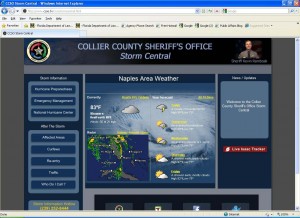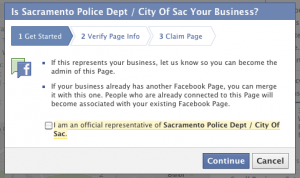Karie Partington is the Public Affairs Manager at the CCSO

The corporate world is known for using dark websites as a crisis management tool, but the Collier County Sheriff’s Office has developed one specially designed to be a community resource during major storm events.
A ‘dark site’ is a pre-prepared and ready-to-publish site to facilitate information sharing in the event of a crisis or emergency. In this case, the emergency was the growing and rapidly approaching Tropical Storm Isaac.
“I felt it was important to provide our community with comprehensive news and information that would help them not only prepare for the storm and track its approach, but also be a resource afterward by providing specifics about storm damage,” said Sheriff Kevin Rambosk.
Sheriff Rambosk said the website is the first of its kind in Southwest Florida, and possibly the state.
While Isaac ended up tracking westward of Collier County and having a minimal impact locally, it provided the agency with an opportunity to put its dark site to the test.
The site, www.colliersheriff.org, offered a live Isaac Tracker through The Weather Channel and weather updates including a map of current weather conditions through www.accuweather.com. There were links to state and local storm-related resources, including the Collier County Emergency Management website and the National Hurricane Center website.
Visitors could also watch CCSO videos about hurricane preparedness and see educational information, including the proper procedures when traffic signals aren’t functioning. The site also offered contact information for area cable, telephone and electricity providers as a resource for citizens needing to report outages.
A customized Google map displayed the six storm shelters that were activated. Had the community received damage, that information, along with road closures and power outages, would have been mapped as well.
Following any major storm event, deputies are among the first people to go out in the weather. CCSO deputies were prepared to shoot photos and video clips of damaged areas as soon as it was safe to deploy into neighborhoods and e-mail them to the agency’s Public Affairs staff to be shared with the community quickly.
Quick access to photos and videos and maps of affected areas is particularly critical in Collier County because hurricane season runs from June 1 to Nov. 30, when many property owners are up north. Thanks to the photos, videos and maps of damaged areas, finding accurate information on how their neighborhood fared during the storm is as simple as visiting www.colliersheriff.org.
Importantly, site visitors were still able to reach the agency’s standard website and all of its content via a handy button on the home page. Other buttons provided access to the agency’s Facebook and Twitter pages and its video site, www.ccso.tv.
The site was taken down after Isaac passed Southwest Florida, but it will be activated again the next time a major storm threatens Collier County.






 However, sometimes pages are created by Facebook when someone selects an associated interest or when someone checks in to a location. Those pages are called Community Pages, and they’re accompanied by a briefcase or a geo-location pin as an icon.
However, sometimes pages are created by Facebook when someone selects an associated interest or when someone checks in to a location. Those pages are called Community Pages, and they’re accompanied by a briefcase or a geo-location pin as an icon. The Collier County Sheriff’s Office is Storm Central for Tropical Storm Isaac.
The Collier County Sheriff’s Office is Storm Central for Tropical Storm Isaac.